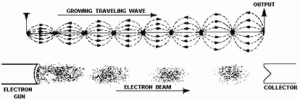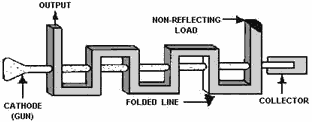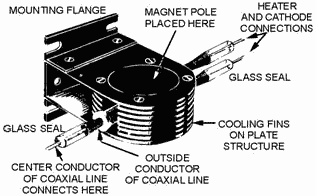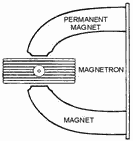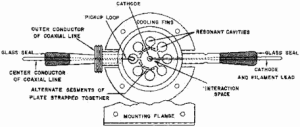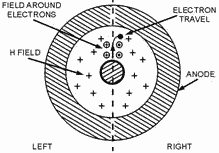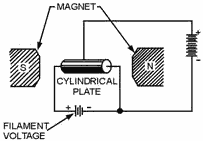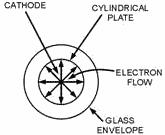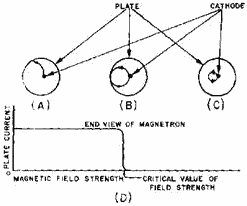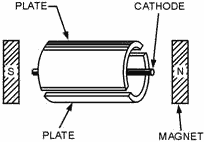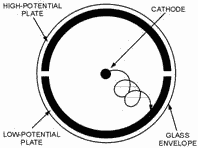Navy Electricity and Electronics Training Series (NEETS)
|
||||||||||||||||||||||||||||||||||||||||||||||||||
|
Module 11 − Microwave Principles
Pages i, 1−1, 1−11, 1−21, 1−31, 1−41, 1−51, 1−61, 2−1, 2−11, 2−21, 2−31, 2−41, 2−51, 2−61, 3−1, 3−11, AI−1, Index−1, Assignment 1, Assignment 2
wide range of RF frequencies if it is terminated in the characteristic impedance of the line. The electromagnetic waves traveling down the line produce electric fields that interact with the electrons of the beam. If the electrons of the beam were accelerated to travel faster than the waves traveling on the wire, bunching would occur through the effect of velocity modulation. Velocity modulation would be caused by the interaction between the traveling-wave fields and the electron beam. Bunching would cause the electrons to give up energy to the traveling wave if the fields were of the correct polarity to slow down the bunches. The energy from the bunches would increase the amplitude of the traveling wave in a progressive action that would take place all along the length of the TWT, as shown in figure 2-14. However, because the waves travel along the wire at the speed of light, the simple TWT shown in figure 2-14 will not work. At present no way is known to accelerate an electron beam to the speed of light. Since the electron beam cannot travel faster than the wave on the wire, bunching will not take place and the tube will not work. The TWT is therefore designed with a delay structure to slow the traveling wave down to or below the speed of the electrons in the beam. a common TWT delay structure is a wire, wound in the form of a long coil or helix, as shown in figure 2-15, view (A). The shape of the helix slows the effective velocity of the wave along the common axis of the helix and the tube to about one-tenth the speed of light. The wave still travels down the helix wire at the speed of light, but the coiled shape causes the wave to travel a much greater total distance than the electron beam. The speed at which the wave travels down the tube can be varied by changing the number of turns or the diameter of the turns in the helix wire. The helical delay structure works well because it has the added advantage of causing a large proportion of electric fields that are parallel to the electron beam. The parallel fields provide maximum interaction between the fields and the electron beam.
2-21 In a typical TWT, the electron beam is directed down the center of the helix while, at the same time, an RF signal is coupled onto the helix. The electrons of the beam are velocity-modulated by the electric fields produced by the RF signal. Amplification begins as the electron bunches form and release energy to the signal on the helix. The slightly amplified signal causes a denser electron bunch which, in turn, amplifies the signal even more. The amplification process is continuous as the RF wave and the electron beam travel down the length of the tube. Any portion of the TWT output signal that reflects back to the input will cause oscillations within the tube which results in a decrease in amplification. Attenuators are placed along the length of the helix to prevent reflections from reaching the input. The attenuator causes a loss in amplitude, as can be seen in figure 2-15, view (B), but it can be placed so as to minimize losses while still isolating the input from the output. The relatively low efficiency of the TWT partially offsets the advantages of high gain and wide bandwidth. The internal attenuator reduces the gain of the tube, and the power required to energize the focusing magnet is an operational loss that cannot be recovered. The TWT also produces heat which must be dissipated by either air-conditioning or liquid-cooling systems. All of these factors reduce the overall efficiency of the TWT, but the advantages of high gain and wide bandwidth are usually enough to overcome the disadvantages. The Backward-Wave Oscillator The BACKWARD-WAVE Oscillator (BWO) is a microwave-frequency, velocity-modulated tube that operates on the same principle as the TWT. However, a traveling wave that moves from the
2-22 electron gun end of the tube toward the collector is not used in the BWO. Instead, the BWO extracts energy from the electron. beam by using a backward wave that travels from the collector toward the electron gun (cathode). Otherwise, the electron bunching action and energy extraction from the electron beam is very similar to the actions in a TWT.
Figure 2-16 - Typical BWO. The typical BWO is constructed from a folded transmission line or waveguide that winds back and forth across the path of the electron beam, as shown in figure 2-16. The folded waveguide in the illustration serves the same purpose as the helix in a TWT. The fixed spacing of the folded waveguide limits the bandwidth of the BWO. Since the frequency of a given waveguide is constant, the frequency of the BWO is controlled by the transit time of the electron beam. The transit time is controlled by the collector potential. Thus, the output frequency can be changed by varying the collector voltage, which is a definite advantage. As in the TWT, the electron beam in the BWO is focused by a magnet placed around the body of the tube. Q-26. What is the primary use of the TWT? Q-27. The magnet surrounding the body of a TWT serves what purpose? Q-28. How are the input and output directional couplers in a TWT connected to the helix? Q-29. What relationship must exist between the electron beam and the traveling wave for bunching to occur in the electron beam of a TWT? Q-30. What structure in the TWT delays the forward progress of the traveling wave? The Magnetron The MAGNETRON, shown in figure 2-17A, is a self-contained microwave oscillator that operates differently from the linear-beam tubes, such as the TWT and the klystron. Figure 2-17B is a simplified drawing of the magnetron. CROSSED-ELECTRON and Magnetic fields are used in the magnetron to produce the high-power output required in radar and communications equipment.
2-23 The magnetron is classed as a diode because it has no grid. a magnetic field located in the space between the plate (anode) and the cathode serves as a grid. The plate of a magnetron does not have the same physical appearance as the plate of an ordinary electron tube. Since conventional inductive- capacitive (LC) networks become impractical at microwave frequencies, the plate is fabricated into a cylindrical copper block containing resonant cavities which serve as tuned circuits. The magnetron base differs considerably from the conventional tube base. The magnetron base is short in length and has large diameter leads that are carefully sealed into the tube and shielded. The cathode and filament are at the center of the tube and are supported by the filament leads. The filament leads are large and rigid enough to keep the cathode and filament structure fixed in position. The
2-24 output lead is usually a probe or loop extending into one of the tuned cavities and coupled into a waveguide or coaxial line. The plate structure, shown in figure 2-18, is a solid block of copper. The cylindrical holes around its circumference are resonant cavities. a narrow slot runs from each cavity into the central portion of the tube dividing the inner structure into as many segments as there are cavities. Alternate segments are strapped together to put the cavities in parallel with regard to the output. The cavities control the output frequency. The straps are circular, metal bands that are placed across the top of the block at the entrance slots to the cavities. Since the cathode must operate at high power, it must be fairly large and must also be able to withstand high operating temperatures. It must also have good emission characteristics, particularly under return bombardment by the electrons. This is because most of the output power is provided by the large number of electrons that are emitted when high-velocity electrons return to strike the cathode. The cathode is indirectly heated and is constructed of a high- emission material. The open space between the plate and the cathode is called the INTERACTION SPACE. In this space the electric and magnetic fields interact to exert force upon the electrons. The magnetic field is usually provided by a strong, permanent magnet mounted around the magnetron so that the magnetic field is parallel with the axis of the cathode. The cathode is mounted in the center of the interaction space.Basic MAGNETRON Operation. Magnetron theory of operation is based on the motion of electrons under the influence of combined electric and magnetic fields. The following information presents the laws governing this motion. The direction of an electric field is from the positive electrode to the negative electrode. The law governing the motion of an electron in an electric field (E field) states: The force exerted by an electric field on an electron is proportional to the strength of the field. Electrons tend to move from a point of negative potential toward a positive potential.
2-25
Figure 2-19 - Electron motion in an electric field.
Figure 2-20 - Electron motion in a magnetic field.
Figure 2-21A - Basic magnetron. SIDE VIEW.
Figure 2-21B - Basic magnetron. END VIEW OMITTING MAGNETS.
Figure 2-22 - Effect of a magnetic field on a single electron. This is shown in figure 2-19. In other words, electrons tend to move against the E field. When an electron is being accelerated by an E field, as shown in figure 2-19, energy is taken from the field by the electron. The law of motion of an electron in a magnetic field (H field) states: The force exerted on an electron in a magnetic field is at right angles to both the field and the path of the electron. The direction of the force is such that the electron trajectories are clockwise when viewed in the direction of the magnetic field. This is shown in figure 2-20. In figure 2-20, assume that a south pole is below the figure and a north pole is above the figure so that the magnetic field is going into the paper. When an electron is moving through space, a magnetic field builds around the electron just as it would around a wire when electrons are flowing through a wire. In figure 2-20 the magnetic field around the moving electron adds to the permanent magnetic field on the
2-26 left side of the electron's path and subtracts from the permanent magnetic field on the right side. This action weakens the field on the right side; therefore, the electron path bends to the right (clockwise). If the strength of the magnetic field is increased, the path of the electron will have a sharper bend. Likewise, if the velocity of the electron increases, the field around it increases and the path will bend more sharply. A schematic diagram of a basic magnetron is shown in figure 2-21A. The tube consists of a cylindrical plate with a cathode placed along the center axis of the plate. The tuned circuit is made up of cavities in which oscillations take place and are physically located in the plate. When no magnetic field exists, heating the cathode results in a uniform and direct movement of the field from the cathode to the plate, as illustrated in figure 2-21B. However, as the magnetic field surrounding the tube is increased, a single electron is affected, as shown in figure 2-22. In figure 2-22, view (A), the magnetic field has been increased to a point where the electron proceeds to the plate in a curve rather than a direct path.
2-27 In view (B) of figure 2-22, the magnetic field has reached a value great enough to cause the electron to just miss the plate and return to the filament in a circular orbit. This value is the CRITICAL Value of field strength. In view (C), the value of the field strength has been increased to a point beyond the critical value; the electron is made to travel to the cathode in a circular path of smaller diameter. View (D) of figure 2-22. shows how the magnetron plate current varies under the influence of the varying magnetic field. In view (A), the electron flow reaches the plate, so a large amount of plate current is flowing. However, when the critical field value is reached, as shown in view (B), the electrons are deflected away from the plate and the plate current then drops quickly to a very small value. When the field strength is made still greater, as shown in view (C), the plate current drops to zero. When the magnetron is adjusted to the cutoff, or critical value of the plate current, and the electrons just fail to reach the plate in their circular motion, it can produce oscillations at microwave frequencies. These oscillations are caused by the currents induced electrostatically by the moving electrons. The frequency is determined by the time it takes the electrons to travel from the cathode toward the plate and back again. a transfer of microwave energy to a load is made possible by connecting an external circuit between the cathode and the plate of the magnetron. Magnetron oscillators are divided into two classes: Negative-Resistance and ELECTRON-RESONANCE MAGNETRON Oscillators. A negative-resistance magnetron oscillator is operated by a static negative resistance between its electrodes. This oscillator has a frequency equal to the frequency of the tuned circuit connected to the tube. An electron-resonance magnetron oscillator is operated by the electron transit time required for electrons to travel from cathode to plate. This oscillator is capable of generating very large peak power outputs at frequencies in the thousands of megahertz. Although its average power output over a period of time is low, it can provide very high-powered oscillations in short bursts of pulses. Q-31. The folded waveguide in a BWO serves the same purpose as what component in a TWT?
2-28 Q-32. What serves as a grid in a magnetron? Q-33. a cylindrical copper block with resonant cavities around the circumference is used as what component of a magnetron? Q-34. What controls the output frequency of a magnetron? Q-35. What element in the magnetron causes the curved path of electron flow? Q-36. What is the term used to identify the amount of field strength required to cause the electrons to just miss the plate and return to the filament in a circular orbit? Q-37. a magnetron will produce oscillations when the electrons follow what type of path?
Negative-Resistance MAGNETRON.
Figure 2-23A - Split-anode magnetron.
Figure 2-23B - Split-anode magnetron.
Figure 2-24 - Movement of an electron in a split-anode magnetron. The split-anode, negative-resistance magnetron is a variation of the basic magnetron which operates at a higher frequency. The negative-resistance magnetron is capable of greater power output than the basic magnetron. Its general construction is similar to the basic magnetron except that it has a split plate, as shown in figure 2-23A and B. These half plates are operated at different potentials to provide an electron motion, as shown in figure 2-24. The electron leaving the cathode and progressing toward the high-potential plate is deflected by the magnetic field and follows the path shown in figure 2-24. After passing the split between the two plates, the electron enters the electrostatic field set up by the lower-potential plate.
2-29 Here the magnetic field has more effect on the electron and deflects it into a tighter curve. The electron then continues to make a series of loops through the magnetic field and the electric field until it finally arrives at the low-potential plate. Oscillations are started by applying the proper magnetic field to the tube. The field value required is slightly higher than the critical value. In the split-anode tube, the critical value is the field value required to cause all the electrons to miss the plate when its halves are operating at the same potential. The alternating voltages impressed on the plates by the oscillations generated in the tank circuit will cause electron motion, such as that shown in figure 2-24, and current will flow. Since a very concentrated magnetic field is required for the negative-resistance magnetron oscillator, the length of the tube plate is limited to a few centimeters to keep the magnet at reasonable dimensions. In addition, a small diameter tube is required to make the magnetron operate efficiently at microwave frequencies. A heavy-walled plate is used to increase the radiating properties of the tube. Artificial cooling methods, such as forced-air or water-cooled systems, are used to obtain still greater dissipation in these high-output tubes.
2-30
|
||||||||||||||||||||||||||||||||||||||||||||||||||
